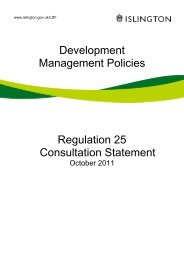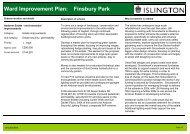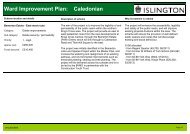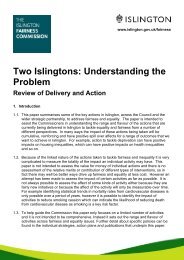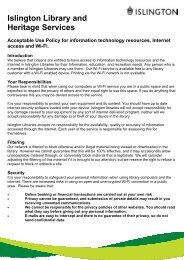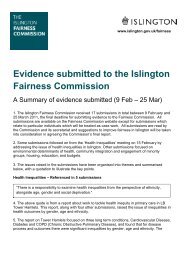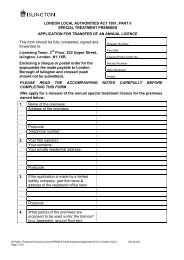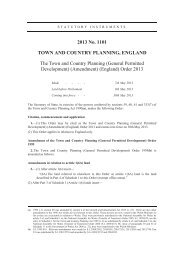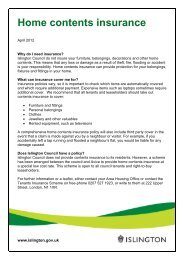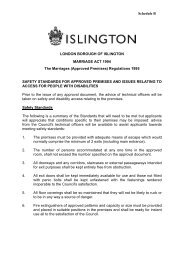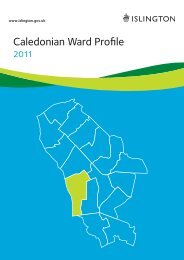Enforcement Contract - Payment Mechanism - Islington Council
Enforcement Contract - Payment Mechanism - Islington Council
Enforcement Contract - Payment Mechanism - Islington Council
Create successful ePaper yourself
Turn your PDF publications into a flip-book with our unique Google optimized e-Paper software.
PAYMENT MECHANISM<br />
This is a four-part payment mechanism with Core Cost, Performance Risk, KQPI and Value for<br />
Money elements.<br />
A broad outline of the intended remuneration methodology is produced below.<br />
1<br />
ELEMENT DESCRIPTION MAKE-UP FREQUENCY<br />
CORE CONTRACT<br />
COST<br />
Submissions,<br />
Charges, less;<br />
Savings made<br />
against original<br />
predictive<br />
contract costs<br />
Recharges<br />
Resource<br />
provision,<br />
contract<br />
overhead,<br />
company return<br />
on investment,<br />
expected<br />
surplus<br />
Reconciled and<br />
invoiced Monthly<br />
in arrears.<br />
2<br />
PERFORMANCE<br />
RISK BOND<br />
ELEMENT<br />
<strong>Contract</strong>or<br />
‘Bond’ to be<br />
Offset against the<br />
Compliance<br />
KQPI<br />
Parking<br />
Compliance,<br />
Service<br />
improvement<br />
and percentage<br />
of correctly<br />
issued PCN<br />
quantifiable by<br />
benchmarked<br />
indicators’<br />
Reconciled and<br />
invoiced<br />
Quarterly in<br />
arrears.<br />
Submissions<br />
against<br />
remaining KQPI<br />
on quality<br />
performance<br />
3 KQPI ELEMENT standards<br />
Contingency<br />
amount for<br />
contract<br />
development,<br />
hardware or<br />
4 VFM ELEMENT training etc<br />
Benchmarked<br />
quality KPI to<br />
establish<br />
standard for<br />
qualification<br />
<strong>Contract</strong><br />
development<br />
scheme, a<br />
rolling 12-month<br />
program for<br />
contract<br />
maintenance<br />
Reconciled and<br />
invoiced Bi-<br />
Annually in<br />
arrears.<br />
Reconciled<br />
Quarterly<br />
Re-charged<br />
Annually in<br />
arrears.<br />
CORE COST<br />
The contractor must provide within their Bill of Quantities a complete breakdown of contract<br />
charges as an attachment to their Method Statement tender return.<br />
Core cost charges shall include but not be limited to; Head office overhead, investment return,<br />
administrative costs, human resource funding, sundries and consumables, licenses and fees, IT<br />
software and hardware, vehicles and other physical equipment, development funding and contract<br />
surplus.<br />
Failure to provide any part of the core service(s) will be subject to commensurate contract recharge<br />
via credit note.<br />
Within seven days of month end, the contractor will provide the CAO with a statement of charges<br />
for each calendar month, for reconciliation and shall include recharge application as a separate<br />
item where appropriate.<br />
Upon agreement of the statement by the CAO, the contractor may submit a formal invoice of<br />
services’ for that calendar month and a relevant credit note as applicable.<br />
The contractor is tasked to carry out a continual review of core cost charges with the aim of<br />
reducing the councils’ liability.<br />
The CAO will work closely with the contractor’s representative(s) to identify and agree these<br />
savings.<br />
Confidential Page 1 27/05/2009
PERFORMANCE RISK BOND<br />
The contractor must ‘risk’ a percentage of their expected contract surplus, against achievement of<br />
selected Key Quality Performance Indicators, which in the first instance, are defined as:<br />
For Lot 1 Headline KQPI:;<br />
1. Percentage of correctly issued penalty charge notice<br />
2. Level of parking compliance.<br />
For Lot 2 Supplementary KQPI;<br />
4. Immobilisation and Removal and Abandoned Vehicle operation<br />
The ‘risk’ percentage to be offered is at the discretion of the contractor as a competitive element of<br />
their tender bid and must be provided for in the Bill of Quantities summary as a financial value.<br />
The exact subsequent apportionment and success or failure measurement to be applied will be<br />
agreed by the Partnership Panel prior to contract commencement, but for the avoidance of doubt<br />
may be assumed to be.<br />
1. 99% achievement qualifies for a pass<br />
2. 85% or greater, on-street parking compliance and ticket issue combined<br />
4. 99% accuracy of enforcement actions taken<br />
The contractors’ performance on compliance/enforcement will be reconciled and invoiced quarterly<br />
in arrears, however should the contractor fail to achieve the agreed compliance percentages, their<br />
quarterly ‘risk bond’ shall be deemed forfeit.<br />
KQPI ELEMENT<br />
Headline KQPI Menu<br />
Initial KQPI will be confirmed by the Partnership Panel prior to commencement of contract but can<br />
be assumed to include the following items.<br />
1. Percentage of correctly issued penalty charge notice<br />
2. Level of parking compliance<br />
3. Percentage of upheld complaint<br />
4. Quality and retention of staff<br />
5. Resource, supply and deployment<br />
6. Sustainability objectives<br />
Headline KQPI Outline<br />
1. Percentage of correctly issued penalty charge notice<br />
Incorrectly issued penalty notices cause inconvenience and distress and damage the reputation of<br />
the <strong>Council</strong>. By monitoring incorrectly issued penalty notices, cancelled due to avoidable contractor<br />
error, a measure can be applied to identify the cause and reduce any likely hood of continued<br />
incorrect issue.<br />
There is also a quantifiable cost to the <strong>Council</strong> inherent in the process for administering these<br />
errors, further, in any unrecoverable element, where a ticket could have been legitimately issued.<br />
In order to monitor compliance with this KQPI a benchmark percentile of 99% accuracy will be set,<br />
allowing 1% for natural human error. The contractor will receive an evidence pack for each<br />
individual PCN cancelled for CEO error, allowing an opportunity for challenge. The contractor will<br />
be deemed to have satisfied the KQPI with an accuracy ratio of 99% or above in any 3-month<br />
quarter.<br />
Further, in order to promote user good will and to alleviate the negative ‘time and trouble’ value<br />
experienced by the appelant in making a representation against the penalty, a punitive<br />
compensation amount of £25 will be paid by the contractor in each case where it is demonstrated,<br />
on an evidence or balance of probability basis, that the penalty notice was unnecessarily issued.<br />
Confidential Page 2 27/05/2009
Qualification for appealant compensation, due to contractor error, will be determined where it may<br />
be shown that the contractor issued a penalty notice in circumstances were the contractor may<br />
reasonably have been aware, that a penalty charge notice should not have been issued; IE:<br />
Contrary to a client instruction or in a non-enforceable location or due to insufficient trtaining or<br />
supervision.<br />
Exclusions will include, parking charge notice cancellation on grounds of council discretion, such<br />
as compassion, subsequent council policy change or deminimis failure; IE incorect vehicle<br />
registration, make, colur or location etc.<br />
2. Level of on street parking compliance<br />
This KQPI is intended to monitor the overall effectiveness of the service key aim for the<br />
‘expeditious movement of ‘traffic’ including pedestrians’.<br />
Compliance will be partially benchmarked against the <strong>Council</strong>s position using external body (TfL)<br />
performance tables when available, supported by a 'compliance improvement plan', measuring<br />
with the application of monitoring tools such as, mystery vehicle identification and street<br />
compliance and parking place occupancy surveys’.<br />
Compliance measurement will be arranged by the CAO, whereby sample surveys will be<br />
undertaken at various locations throughout the borough, an assessment made of the number of<br />
vehicles in contravention and an account taken for the number of vehicles contravening, which,<br />
have received enforcement.<br />
The CAO will survey a minimum twenty locations in a calendar month, noting parking bay<br />
occupancy by type, valid permit, blue badge etc.<br />
Such surveys may consist of, but may not be limited to, any combination of measures to include,<br />
finding a mystery car, logging of persistent evaders, persistent offenders and blue badge fraud<br />
cases using automatic number plate recognition, by covert CCTV monitoring or by physical beat<br />
sampling by parking officers.<br />
Then by assessing a percentage compliance figure; for example, if one hundred vehicles surveyed<br />
and 80% with valid permissions to park, then 20% in contravention, of which a contractor<br />
performance measure would be applied for 5% to be issued with a valid, robust and enforceable<br />
penalty charge notice.<br />
Thereby a combined percentage of ‘compliance’ and ‘enforcement’ of 85%, or over equates to a<br />
performance standard pass mark.<br />
A similar study and measure would be applied to yellow line, waiting and loading restrictions etc.<br />
The contractor will receive any benefit attributable to this particular KQPI from their annual<br />
performance risk reserve. This will be a monthly reconciled performance measure with an annual<br />
settlement date.<br />
In order to establish this benchmark, the partnership panel will set an activity level commensurate<br />
with historical pcn data.<br />
3. Percentage of upheld complaint<br />
When complaints’ are received, either through the Central Complaint system or directly at Parking<br />
Services or via the contractor, they will be fully investigated and an outcome defined.<br />
When it is the case that culpability can be apportioned to the contractor, then this KQPI will track<br />
the event. A benchmark rejection rate will be set by the partnership panel, taking account of<br />
current statistic available for 2007.<br />
Further, in order to promote user good will and to alleviate the negative ‘time and trouble’ value<br />
experienced by the appelant in making a formal complaint against the contractor, a punitive<br />
compensation amount of £25 will be paid by the contractor in each case where it is demonstrated,<br />
on an evidence or balance of probability basis, that the contractor employee was at fault.<br />
Confidential Page 3 27/05/2009
4. Quality and retention of staff<br />
Staff retention is an indicative proxy for the service supplier’s ability to provide continuity and to<br />
maintain high staff performance standards.<br />
Retraining new recruits is not only expensive but carries additional negative weight whilst the<br />
recruit adapts to the local anomalies and nuances of parking within <strong>Islington</strong>. This KQPI is intended<br />
to encourage the service supplier to invest in the long-term development of the <strong>Islington</strong> staff base.<br />
The contractor is reminded of islington requirement to actively recruit from within our local<br />
community where possible.<br />
Historically, staff retention on comparable contracts is around 30% annually and this figure will be<br />
taken as the watermark above which goals for improvement will be set.<br />
5. Resource, supply and deployment<br />
The supply and deployment of correctly trained supervised and motivated staff and the supply of<br />
relevant support resources have a significant impact on service performance.<br />
This KQPI is designed as a focal point for ‘good-housekeeping’ measures, employed to maintain<br />
agreed service levels.<br />
The contractor will provide a monthly report documenting resource provision, as an<br />
accompaniment to their certified invoice.<br />
Measurement of suspensions service<br />
An ICPS generated report showing the amount of days taken from date of suspension order to<br />
date of suspension commencement, listing the number of days where the suspension has been<br />
entered onto the "On work warning list".<br />
An ICPS generated report showing the amount of days taken from date of suspension order to<br />
date to "Modified" to "On work warning list".<br />
An ICPS generated report showing the amount of days taken from date of "Notices Out" to "In<br />
Place"<br />
A management report which monitors the PA's movements during operational hours of duty.<br />
Photographic evidence of all actions taken regarding any suspension, IE photo's of advanced<br />
warning notices, bags, modified suspension notices and for suspension decommisions.<br />
Successful achievement of this KQPI is deemed to be 97% or above, on current statistic this<br />
equates to one error per operational day for the period measured, errors will be graded, serious,<br />
such as non-commisioning of an ordered suspension and de-minimis, such as a missing<br />
photograph, aligned to a service continual improvement plan with aspiration toward 100%<br />
compliance within 3 years.<br />
Measurement of parking and CCTV enforcement service(s)<br />
The Partnership Panel are tasked to define the contract drivers that will underpin the key quality<br />
performance indicators within the headline and supplementary KQPI menus’.<br />
Agreed service levels and benchmarks must be drawn up prior to contract commencement,<br />
monitored continuously and reviewed quarterly.<br />
6. Sustainability objectives<br />
This KQPI must demonstrate continued improvement on benchmarks for agreed sustainable<br />
projects and initiatives. Each project or initiative will be given a performance improvement aim or<br />
percentile, against which the contractors’ compliance will be measured. This KQPI is designed to<br />
embed the sustainability ethos into the contract term.<br />
Initial sustainability KQPI objectives will be designed by the Partnership Panel based on the ‘startup’<br />
position of the contractor, following which a year on year improvement plan will be instigated.<br />
Confidential Page 4 27/05/2009
Supplementary KQPI Menu Outline<br />
This further menu of KQPI, to be developed by the partnership panel, may be substituted with<br />
initial KQPI as individual elements shift in priority or are substantially achieved.<br />
1. Percentage of supervisory support<br />
2. Bus lane compliance<br />
3. Percentage for CEO error cancellation<br />
4. Immobilisation and Removal and Abandoned Vehicle operation<br />
Prior to commencement of contract, the Partnership Panel will assess and agree the value or<br />
benefit attributable to each KQPI with the exceptions of KQPI, which are solely formulated in the<br />
performance risk element.<br />
1. Percentage of supervisory support<br />
This performance measurement will calculate, by a daily analysis of team leader pocket books’, to<br />
determine apportionment of time allotted in support of their teams.<br />
2. Bus lane compliance<br />
Transport for London statistics on bus throughput times will be used by the CAO as a proxy for<br />
compliance on the Transport for London Road Network where applicable to the <strong>Islington</strong> contract.<br />
3. Percentage for CEO error cancellation<br />
This performance assessment will be calculated on the number of PCN cancelled due to avoidable<br />
CEO error, measured as a percentage of total PCN issued.<br />
4. Immobilisation, Removal and Abandoned vehicle operation<br />
The correct operation of a further enforcement service, immobilisation, removals and abandoned<br />
vehicle, will serve to underpin the frontline enforcement service and add weight to the compliance<br />
drive.<br />
Measurements will be taken by the CAO for contractor adherence to policy and for priority<br />
enforcement, in particular in relation to dangerous parking , disabled parking space obstruction,<br />
blue badge fraud, persistent evaders, persitent offender and untaxed nusiance vehicles.<br />
Dangerous parking<br />
Classified by contravention code in conjunction with the Guide for Priority attached as Appendix J.<br />
The contractor will be monitored on the percentage or number of dangerous parking<br />
contraventions enforced against as a proportion of the monthly pcn issue.<br />
Disabled Parking Place Obstruction<br />
Classified by contravention code in conjunction with the Guide for Priority attached as Appendix J.<br />
The contractor will be monitored on the percentage or number of disable parking place<br />
contraventions enforced against as a proportion of the monthly pcn issue.<br />
Blue Badge Fraud<br />
Identified by the CAO or by specially trained contractor operatives.<br />
The contractor will be monitored on the percentage or number of blue badge fraud contraventions<br />
enforced against as a proportion of those reported each month.<br />
Persistent evader<br />
Classified as a vehilce with three or more pcn issued within the preceeding six months which, have<br />
not been paid, are not subject to appeal, are not on hold and have not reached warrant.<br />
ICPS software supplied with the hand held computers will manage the initial on-street element of<br />
persistent evader identification, the contractor will be monitored on the percentage or number of<br />
persistent evaders enforced against as a proportion of the monthly pcn issue.<br />
Confidential Page 5 27/05/2009
Persistent offender<br />
Classified as a vehicle with ten or more pcn issued within the preeceding six months which, have<br />
been pid or remian unpaid.<br />
Data supplied by the CAO will be utilised by the contractor to identify and prioritise the most prolific<br />
offenders. The contractor will be monitored on the percentage or number of persistent offender<br />
enforced against as a proportion of the monthly pcn issue.<br />
Untaxed Nusiance Vehicles<br />
Classified as vehicles in breach of Driver Vehicle Licence Agengy regulation and / or certifiable as<br />
an abandoned vehicle.<br />
The contractor will be monitored on the percentage or number of vehicles against which<br />
appropriate enforcement action has been taken.<br />
VALUE for MONEY ELEMENT<br />
Value for money is a key element in demonstrating the continued sound management of the<br />
contract and the contractor will take an active role in ensuring that adequate control is maintained<br />
over contract expenditure.<br />
To this aim, on a monthly basis, the contractor will maintain and disclose its contract expenditure<br />
and shall remain liable to open book account audit at any time of the councils choosing.<br />
The contractors’ business analyst will continually liaise with the CAO to review and analyse<br />
contract expenditure, revenue streams and financial process.<br />
A notional cost centre with nominal codes must be agreed and set up, with financial monitoring to<br />
ensure a balanced budget is achieved. See appendix F.<br />
Notional Cost Centre<br />
Will include but not be limited to; total employee costs, total supplies and services, total transport<br />
related expenses, total administrative costs and recharges, total agency costs (sub contractor(s)<br />
and other bodies), gross expenditure.<br />
Nominals:<br />
• Employee costs –<br />
Gross pay, overtime, training, liability insurance and interim staffing.<br />
• Total supplies and services –<br />
Purchases general, repair/maintenance, installation services, hardware purchases, and<br />
network charges, staff uniform.<br />
• Total transport related expenses –<br />
Petrol/derv/other, maintenance, fees’/licenses<br />
• Total administrative costs and recharges –<br />
Telephones’, consumables, finance charges’, departmental recharges.<br />
• Total agency costs –<br />
Sub contractors, specialist and consultancy.<br />
Confidential Page 6 27/05/2009
Hardware and equipment<br />
ADDENDUM NOTES<br />
Hardware and equipment provided or supplied, either by the council for the contractors use or<br />
directly by the contractor for use on the contract, will be maintained or replaced by the contractor<br />
as necessary during the life of the contract.<br />
At the end of the contract term, all hardware and equipment will be deemed to have been<br />
purchased by the <strong>Council</strong> and shall revert to <strong>Council</strong> ownership.<br />
Development Funding<br />
The contractor shall provide an element of contract development funding within their core bid.<br />
Any development cost must be identified by the partnership panel and may be submitted for<br />
reconciliation as a draw down charge against the pre-agreed development fund.<br />
<strong>Contract</strong> Surplus<br />
The partnership panel will consider and agree arrangements for the distribution of any ‘unspent’<br />
annual allocation from the Notional Cost Centre Nominals, however in the first instance any<br />
remaining sum will be recharged to the <strong>Council</strong>.<br />
<strong>Contract</strong>or Overspend<br />
In the event that the contractors predictive contract costs exceed the total agreed annual contract<br />
value, such over-spend will be borne by the contractor in full.<br />
Confidential Page 7 27/05/2009



